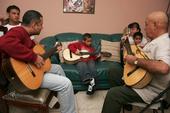Transcript of the Front Page of the Orlando Sentinal article on "Deltona's Music Man".
The Orlando Sentinel
Tanya Perez-Brennan
September 23, 2006
As an 11-year-old boy in Rio Piedras, Puerto Rico , Diomedes Matos walked by the house every day, peering past the fence in wonder at the man on the balcony who cut up wood and molded it into a cuatro.
The man, Roque Navarro, was a legend for the way he played the cuatro, a mini-guitar with 10 strings played by jibaro musicians from Puerto Rico's countryside.
One day, Navarro finally invited him onto the balcony and began to show him how it was done. Five decades later, Matos is gaining world renown as a master builder and player of the cuatro, an instrument that has evolved in Puerto Rico into a national symbol.
Matos, 66, affectionately known to his friends and family as Yomi, was honored Sept. 15 at a reception in Washington, as one of 11 recipients of the prestigious National Heritage Fellowship, worth $20,000 and administered by the National Endowment for the Arts.
'I thought it was a joke,' Matos said in Spanish, as he recalled the moment he received a call from the NEA. 'I was moved and confused like I didn't believe what was happening.'
Now working from his daughter's Deltona garage, Matos makes about eight to 10 cuatros a year. Specialized machines flatten and shape the wood. It takes him about five weeks from start to finish.
He estimates that he has made about 150 cuatros, which range in price from $3,000 to $5,000.
Making cuatros is really a cottage industry, said William Cumpiano, co-founder of The Puerto Rican Cuatro Project, an organization that aims to preserve the cuatro tradition and bring it to a wider audience. Cumpiano is also a good friend of Matos' and is a fellow guitar and cuatro maker.
'Yomi is not only a master cuatro maker, but he's a master cuatro player,' Cumpiano said from his studio in Massachusetts. 'The idea of just being great isn't enough to be a master; you have to be a teacher of your craft to be a master, and that's what Yomi is.'
Paul Simon comes calling Singer/songwriter Paul Simon invited Matos to record on the soundtrack of Simon's Broadway musical, The Capeman, after learning of Matos through his son, Diomedes 'Pucho' Matos, a top salsa bass player.
The NEA fellowships are given out each year and consider artistic excellence, cultural authenticity and community service, said Barry Bergey, director of the folk and traditional-arts program at the NEA. A panel of nine culture experts examines the work of the nominees.
At his daughter's Deltona home, where Matos lives with his wife, Cecilia, he proudly held up the cover of the fellowship program. One of his cuatros graces it.
'This for me,' he said, shaking the program, 'is the greatest thing to happen in my life.'
In the world of the traditional arts, this is the best award anyone could get, said Rita Moonsammy, a folklore expert who nominated Matos and used to work for the New Jersey State Council on the Arts.
'That kind of cuatro, that quality, can't be mass-produced,' she said by phone from New Jersey. 'Yomi's craftsmanship is indisputable.'
He credits Navarro, the master who taught him the craft, for inspiring his passion for the cuatro.
Matos grew up in a Camuy, a village on Puerto Rico's northern coast. By age 9, he was playing the cuatro and the guitar, like most of his musician relatives. By age 12, he had made his first guitar. He grew up around cuatros and jibaro music but, like many of his fellow Puerto Ricans, took it for granted.
Symbol of Puerto Rico Puerto Ricans have a love/hate relationship with the cuatro, Cumpiano said. The attitude of Puerto Ricans toward the instrument was especially telling during times of oppression by colonial powers, he said.
'The Puerto Ricans would express their Puerto Ricanness by brandishing these symbols, these icons,' he said. 'It was what they would grasp at to show that they were something separate from what their colonizers were.'
At age 18, Matos left the island for New Jersey. It was 1958, and the best job he could find was as a worker in an automobile factory. But the music of his homeland was always with him.
He quickly built a reputation as a cuatrista, or cuatro player, and started performing with big names in New York City's music world. That's where he met Yomo Toro, a renowned cuatrista who has bought some of Matos' instruments.
One day in 1965, he was listening to a record of some of the island's greatest cuatristas. And that's when Matos realized the beauty and importance of the instrument he had failed to fully appreciate as a boy.
'I didn't think the instrument was so special,' he said. Matos paused, as tears briefly welled up in his eyes. 'It's got a special sound. It's full of life.'
Soon after, Matos made his first cuatro from a wood native to Puerto Rico called guaraguao. He would later depart from making the cuatros the traditional way and use imported wood from Brazil, Germany and Spain.
At his Deltona home, Matos pulled out two cuatros, one made of light German wood and a much smaller one made for his 8-year-old grandson, Jared. Matos pointed to the inlays of shell he used to decorate the cuatro, including a small flower on the back of its neck.
He looked down at the instrument and beamed.
'This is my second flag,' he said.
Copyright © 2006 The Orlando Sentinel, All Rights Reserved.
